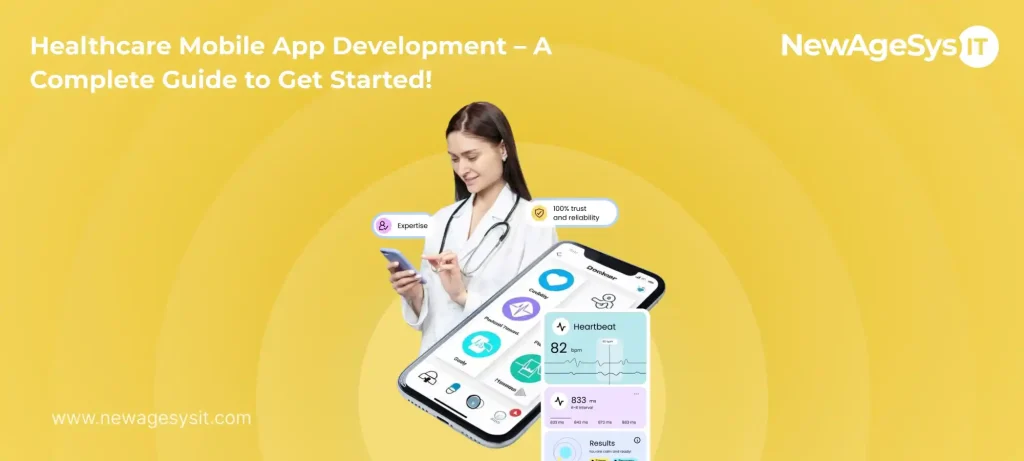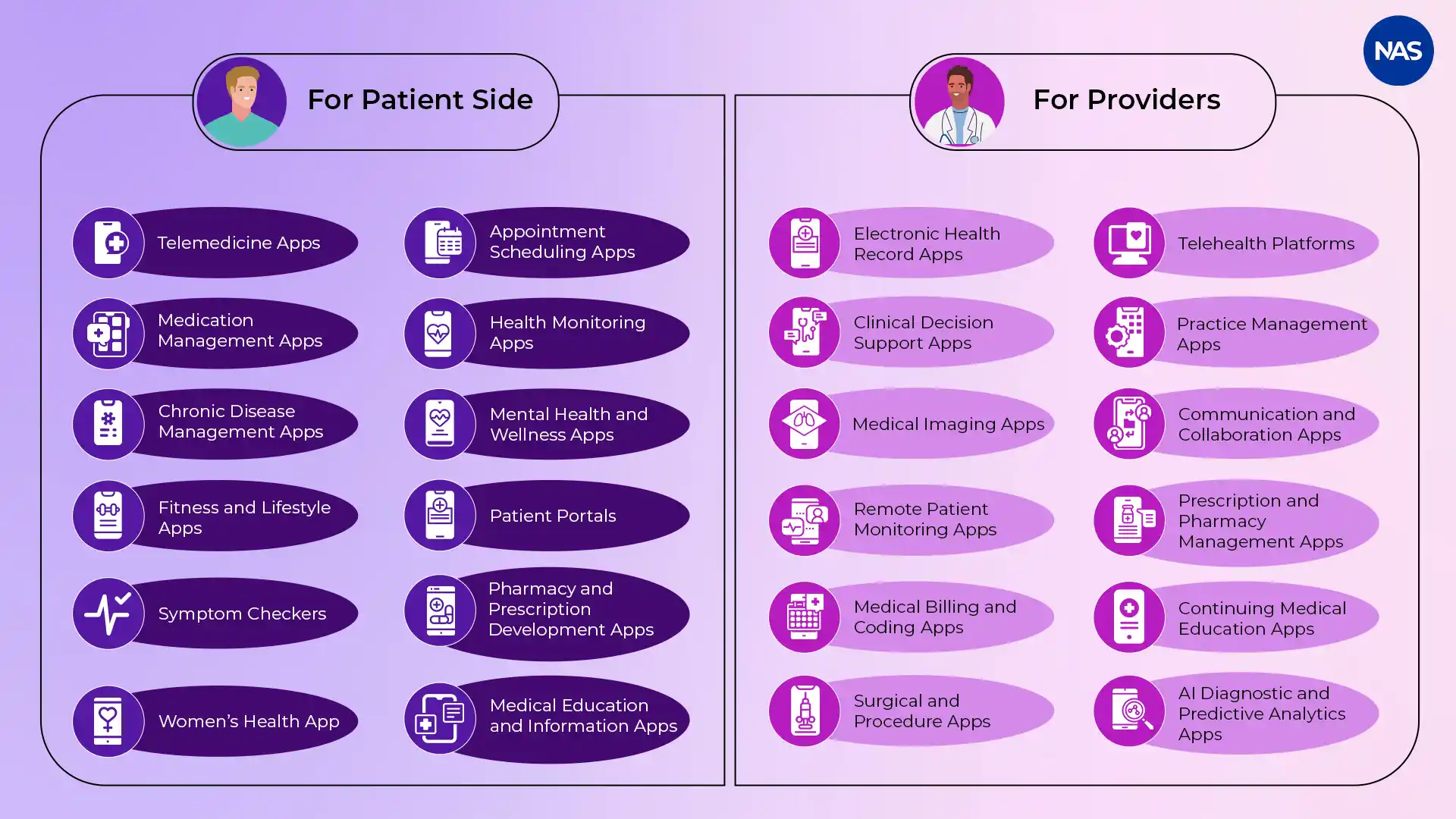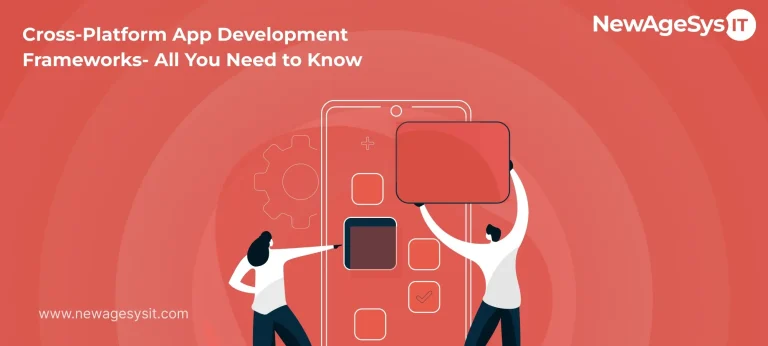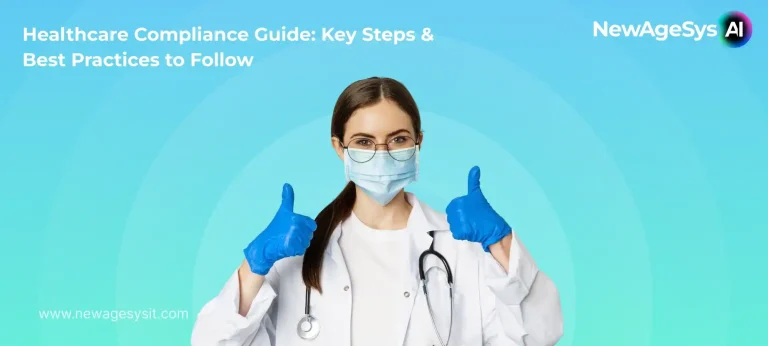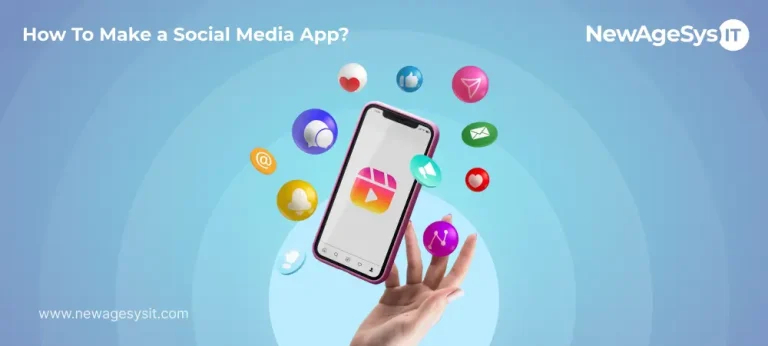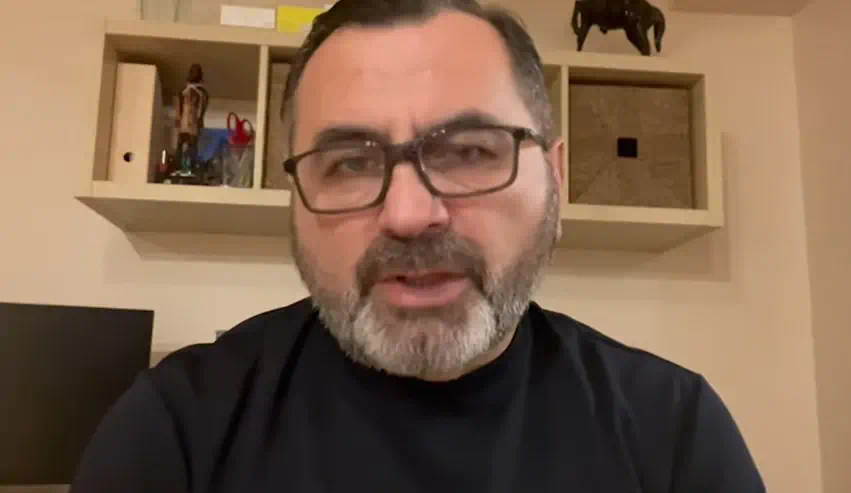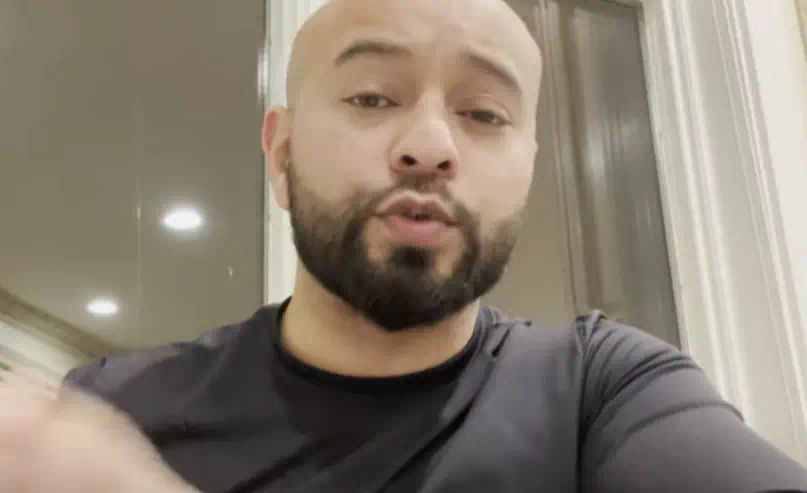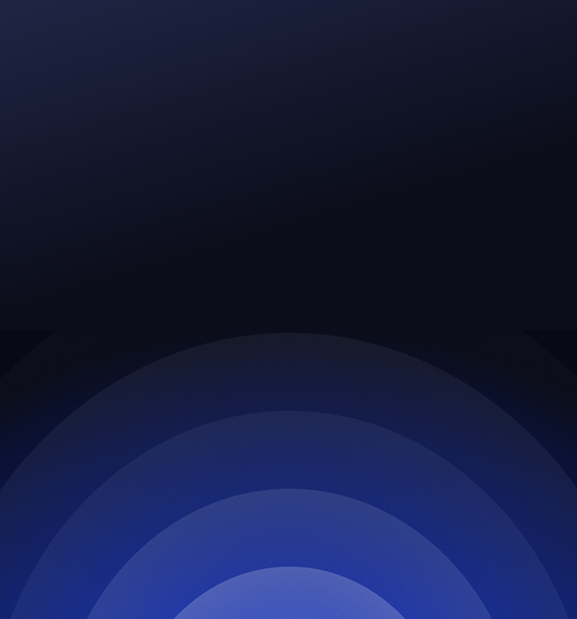Key Takeaways:
- The U.S. digital health market is booming with an expected 54+bn revenue in 2025 and expansion with a CAGR of 6.71%; this includes apps for both patients and providers that offer big revenue potential.
- Around 24+ app categories in the market with a decent market size.
- It is important to integrate must-have (EHR, scheduling) + new-age (AI, voice UI, gamification) features today for a competitive edge.
- Development for a healthcare app ranges from $25K–$400K+, depending on features and complexity.
Mhealth, since and post-2020, after COVID-19 hit, has become an attractive niche to become revenue-positive. In fact, with the global mHealth apps market reaching $37.5 billion last year, i.e., 2024, investing in healthcare mobile app development clearly sustains its position as the ‘talk of the town’.
However, there are tons of different facets to uncover before you begin the actual development process, be it through an in-house team or someone credible like NewAgeSys. And, at NewAgeSys, we understand that before you begin any journey, it is important to understand the best route possible. Here, it is in the context of healthcare application development. So, with this guide, we will be telling you about the different types of healthcare apps to venture into, benefits, associated costs, trends to follow, compliances, and practically everything to give you a good head start.
Note: Healthcare app development is done on two fronts, i.e., patient and provider. So, our guide will delve into both of these aspects, as they both offer unique opportunities to tap.
Types of Healthcare Apps (For Patients & Providers)
The types of mHealth apps available are a spectrum that expands between applications that serve patients and service providers. Therefore, to know the different routes your medical mobile app development can take, let’s learn about these types.
Note: The plethora of types mentioned below have self-explanatory names. So, we have only mentioned a brief explanation and their real-world examples for inspiration.
Healthcare Apps for Patients + Market Size
Note: Stats specific to the U.S. for each app type weren’t available from credible sources. So, we mentioned global stats as well, and have specified the stat type for every app type in the bracket. Additionally, due to a lack of credible data, we had mentioned the entire market size instead of the market size specific to that app type. For instance, Health Monitoring Apps and the Digital Health Tracking Market.
| App Category | 2025 Market Size (USD) |
|---|---|
| Telemedicine Apps | $41.5 billion (U.S.) |
| Appointment Scheduling Apps | $711.9 million (Global) |
| Medication Management Apps | $5.07 billion (Global) |
| Health Monitoring Apps | $18.6 billion (Digital Health Tracking Market; Global) |
| Chronic Disease Management Apps | $6.62 billion (Chronic Disease Management Market; Global) |
| Mental Health & Wellness Apps | $7.48 billion (Mental Health only; Global) |
| Fitness & Lifestyle Apps | $652.06 million (Fitness Apps only; Calculated based on CAGR; U.S.) |
| Patient Portals | $4.57 billion (Global) |
| Symptom Checkers | $1.45 billion (Chatbots; Global) |
| Pharmacy & Prescription Development Apps | $2.309 billion (Pharmacy Software; Global) |
| Women’s Health Apps | $5.76 billion (Global) |
| Medical Education & Information Apps | $872.21 million (U.S. Medical Information Market Size) |
1. Telemedicine Apps: Applications that provide virtual consultation through video, voice, or text. Examples include Teladoc, Amwell, etc.
2. Appointment Scheduling Apps: As the name suggests, these apps book, manage, or cancel patient appointments with healthcare providers—for example, Zocdoc, MyChart, etc.
3. Medication Management Apps: Medication Management Apps help patients track medication schedules, set reminders, and even manage prescriptions. Examples include Medisafe, Pill Reminder, etc.
4. Health Monitoring Apps: Apps that allow patients to track vital signs (e.g., heart rate, blood pressure) through wearables or medical devices. Examples are Apple Health, Fitbit, etc. Additionally, check out our future of wearable apps for a better perspective.
5. Chronic Disease Management Apps: Applications that track symptoms and deliver tailored advice for patients with chronic diseases like diabetes, hypertension, asthma, etc. Examples are mySugr, AsthmaMD, etc.
6. Mental Health and Wellness Apps: These apps offer mental health support that includes therapy, meditation assistance, or mood tracking. Common examples include Headspace, Calm, etc.
7. Fitness and Lifestyle Apps: Promote healthy habits through exercise tracking, nutrition planning, and sleep monitoring, sometimes taking the help of wearables. Examples are MyFitnessPal, Strava, etc.
8. Patient Portals: Deliver access to medical records, test results, and communication with healthcare providers in a few clicks—for example, Epic MyChart, Cerner Patient Portal, etc.
9. Symptom Checkers: Applications that allow users to input symptoms and receive diagnoses or recommendations come under this category. A few examples are WebMD, Ada Health, etc.
10. Pharmacy and Prescription Delivery Apps: Apps that facilitate the ordering and delivery of medications or notify of prescription refills. Examples are GoodRx, Capsule, etc.
11. Women’s Health Apps: These apps focus on reproductive health, menstrual cycle tracking, pregnancy, or fertility. Some real-world examples are Flo, Ovia, etc.
12. Medical Education and Information Apps: These applications provide reliable health information, disease education, or self-care tips. Examples include the Mayo Clinic, Healthline, etc.
Healthcare Apps for Providers + Market Size
Note: Similar to patient app types, we weren’t able to find stats for all the types centered around the U.S.
So, we have mentioned the region of the stats in the bracket. Also, in some cases, the entire market size is mentioned as opposed to the market size specific to that type. For instance, Telehealth platforms and the Telehealth market.
| App Category | 2025 Market Size |
|---|---|
| Electronic Health Record (EHR) Apps | $302.32 million (Calculated using CAGR; U.S.) |
| Telehealth Platforms | $53.4 billion (U.S. Telehealth Market) |
| Clinical Decision Support Apps | $2.46 billion (Global) |
| Practice Management Apps | $7.22 billion (U.S.) |
| Medical Imaging Apps | $11.7 billion (Calculated using CAGR; U.S.) |
| Communication & Collaboration Apps | $7.89 billion (Collaboration Software; U.S. and not specific to healthcare) |
| Remote Patient Monitoring Apps | $9.1 billion (U.S.) |
| Prescription & Pharmacy Management Apps | $8.21 billion (U.S.) |
| Medical Billing & Coding Apps | $7.2 billion (Medical Billing & Coding; Calculated using CAGR; Global) |
| Continuing Medical Education Apps | $3.56 billion (U.S.) |
| Surgical & Procedure Assistance Apps | $44.98 million (Surgical Planning Software; U.S.) |
| AI Diagnostic & Predictive Analytics Apps | $1.12 billion (As per the current market scope, considering the 2024 market % of North America) |
1. Electronic Health Record (EHR) Apps: Applications that allow providers to access and update patient records. Examples are Epic Haiku, Cerner Mobile, etc.
2. Telehealth Platforms: Enable providers to conduct virtual consultations remotely. Real-world examples are Doxy.me, Zoom for Healthcare, etc.
3. Clinical Decision Support Apps: These apps provide evidence-based guidelines, drug databases, and diagnostic tools that assist in decision-making. A few examples of them are UpToDate, Epocrates, etc.
4. Practice Management Apps: Streamlines administrative tasks for providers such as scheduling, billing, and patient communication. Common examples are Kareo, SimplePractice, etc.
5. Medical Imaging Apps: Apps that provide a holistic view and analysis of medical images (e.g., X-rays, MRIs) on mobile devices. Examples are OsiriX, Mobile MIM, etc.
6. Communication and Collaboration Apps: Help in facilitating secure messaging and collaboration amongst healthcare teams. Its examples include TigerConnect, Doximity, etc.
7. Remote Patient Monitoring Apps: Apps that enable the monitoring of patients’ health data in real-time. Examples include Biofourmis, Current Health, etc.
8. Prescription and Pharmacy Management Apps: They provide assistance in terms of prescribing medications, checking drug interactions, and managing refills. Their examples in the market are SureScripts, iPrescribe, etc.
9. Medical Billing and Coding Apps: Popular amongst health providers, used for coding of diagnoses and procedures to streamline billing. Examples are EncodePro, ICD10 Consult, etc.
10. Continuing Medical Education (CME) Apps: Offer resources for providers to earn CME credits and stay updated on medical advancements. Examples include Medscape CME, AudioDigest, etc.
11. Surgical and Procedure Assistance Apps: Apps that provide tools for surgical planning, anatomy visualization, or procedure guidance. Real-world examples are Touch Surgery, 3D4Medical, etc.
12. AI Diagnostic and Predictive Analytics Apps: Deliver AI assistance in diagnosing conditions or predicting patient outcomes based on the patient’s historical data. Examples in the market include Viz.ai, Aidoc, etc.
Benefits of Healthcare Mobile Apps for Patients and Providers
A study estimates more than 350,000+ healthcare apps available in the global market after 2023. This emergence can be largely attributed to the immense benefits delivered through these mHealth apps and the lucrative nature of the market.
However, not everyone is bound to win. Why? Well, to deliver a good product, it is important to have a sense of the benefits delivered through the product. After all, the inception of a good product doesn’t begin with an idea, at least today, but rather at the customer’s pain point, which in this context is patient issues. So, these are the few benefits to keep in mind throughout your healthcare mobile app development process.
Benefits of Healthcare Apps for Patients
The United States exhibited a fairly large proportion of its population, around 43% in 2024, to be precise, who were using healthcare applications. This is a huge target market, by all means. However, it is largely consequential to the benefits served through these apps to the patients. Putting a nail on a few, here are some patient benefits of a successful medical app development endeavor, listed below:
- Convenience: Healthcare apps are available 24*7 with in-app chatbots for support. This means 24*7 access to on-demand doctors and telemedicine (subject to service). In addition, these apps provide a holistic view of vital signs (e.g., blood sugar level, heart monitoring) and many other services, enabling patients to make lifestyle changes.
- Engagement: The Journal of Population Therapeutics & Clinical Pharmacology revealed that mHealth applications increase patient engagement, with 78% of users reporting increased adherence. This engagement was largely attributed to factors like increased app usage, health literacy, personalized services, self-management support, and user-friendly design & accessibility.
- Chronic Disease Management: The U.S. Centers for Health and Human Services that the majority of the nation’s population suffers from at least 1 major chronic disease. These diseases include diabetes, hypertension, heart disease, and even cancer. These healthcare applications help with monitoring, managing, and even preventing these issues before they are sewn into the patients’ bodies.
- Cost Savings: The American Journal of Managed Care (AJMC) published a report by the Arizona Health Care Cost Containment System (AHCCCS) by monitoring the Wellth app (digital health platform) between March 2020 to January 2021. The results showcased a reduction of $88.15 over a period of 9 months, with larger reductions enjoyed by people who suffered from chronic illness, primarily attributed to increased medical adherence. Additionally, they also stated that non-adherence can lead to an annual spending of $100 billion to $300 billion in the U.S.
- Access to Information: With 43% of the US population using mHealth applications and the ability of these apps to run 24*7, access to information can be attributed as a convenient factor behind usage. This is especially true when these apps offer access to PHIs, symptom checkers, vital signs data, and other important data points, at the click of a button.
Benefits of Healthcare Apps for Providers
NIH has already stated that the integration of mHealth apps in healthcare has led to positive behavioral changes because of accessibility to healthcare information and services. But, even healthcare providers enjoy the freedom of delivering their services without increasing the footfall of hospital visits, and managing patient health remotely.
However, the freedom is not just limited to service delivery; rather, it has impacted the in-premise workflow too. So, here are some benefits to think about during your medical application development process for providers.
- Efficiency: mHealth applications for providers work on multiple fronts, such as inefficient appointment scheduling, access to real-time patient data, piles of paperwork, etc. With the intervention of mHealth applications, these problems are being addressed with ease.
- Improved Diagnostics: Since mHealth apps have disrupted barriers like real-time data, real-time monitoring, personalized healthcare, etc., the quality of diagnostics has improved. The doctor simply needs to pull out patients’ historical data, ask for current symptoms, and provide remedies & medication with ease, that too remotely.
- Remote Monitoring: Before the advent of mHealth apps, access to healthcare services was a huge issue. However, with the increase in the number of smartphones both in the U.S. and globally + access to the internet has opened doors for remote monitoring. Patients can easily book an appointment through an app, and the doctor can remotely assess the symptoms of the patient through a video call. Additionally, some apps even provide services that enable patients to deliver their blood, urine, or even stool samples from home for lab testing. This is especially fruitful for the elderly, who can have a hard time visiting a hospital without any support.
- Communication: As mentioned earlier, these health applications operate 24*7 with in-built chatbots in place. These chatbots can talk to the patient, gather data, and even recommend the right doctor. To add, doctors can connect with their patients in HD (high-definition) quality depending on the time they choose to go live.
- Cost Reduction: Internal healthcare operations that include financial management, administrative tasks, legal compliance, resource management, etc., are paper-intensive manual tasks. Existing applications like WriteUpp, Meditech, Healthray, etc., make these tasks incredibly easier through automation without creating a paper trail, reducing cost in both stationery and resources.
Must-Have and Latest Features in Healthcare Mobile App Development
Feature selection is important for any healthcare application development process. After all, it will be features that will create a distinction between your application and the competitors’. However, keeping that aside, there are generic features that improve the usability of your application + latest features that competitors may or may not be using, but will surely give your app an edge. So let’s discuss them:
Note: Integration of features like pill reminders, vital signs tracking, telehealth, symptom checker, etc., for your mHealth app development depends on the nature of the app you are developing.
Must-Have Features to Include in Medical Mobile App Development.
🎨 Intuitive UI/UX Design (following best practices)
👤 User Profile
📅 Appointment Scheduling
💳 Billing/Payments
📁 Integrated EHRs
🌐 Multi-Language Support
📊 Dashboard (for patients and providers)
🔔 Notifications
💬 Messaging Capabilities
🤖 In-app Chatbot
🔍 Search Bar
Latest Features to Include in Mobile Health App Development
- AI-powered Recommendations
- Predictive Analytics (for providers & patients for certain app ideas)
- Voice Activated Interfaces (VUIs)
- Blockchain (for secure data management)
- Gamification Elements (for engagement)
- Cross-Platform Interoperability
- Advanced Accessibility Features (High-contrast Modes, Screen Readers, etc.)
- Real-time Data Visualization (mostly for providers)
Build a Healthcare App - Step-by-Step Instructions to Achieve Your Dream App
We have already stated that the digital health app development process is multi-faceted. So, it comprises more than a few steps that showcase reasonable variation, as the app idea changes. However, with the steps below, our aim has been to deliver you a series of steps that are platform-agnostic as well as idea-agnostic. Basically, a blueprint that can be followed to achieve any app idea, showcased as a culmination of steps at each phase from multiple sources.
Process to Develop a Healthcare App (Platform and Idea Agnostic)
Step 1: Conducting Market Research to Find the Right App Type and Market Fit
This step serves as an intermediary between your desired app idea, its current market, identifiable target users, recommended features, competition analysis, and pivots to another type or idea if needed.
As stated earlier, there are more than a few types of mHealth apps available in the market today. And while one market may seem too busy or saturated with competitors, your aim should be to find the precise point where unresolved pain points exist.
However, it is important to note that this doesn’t mean ditching your existing idea of developing a telemedicine, EHR, fitness, or mental health app. Contrarily, it is to find the right market fit where customers today are underserved or not served at all. To add, disruption doesn’t always mean bringing something new to the table rather bringing something that takes the niche a notch higher.
Step 2: Define Features and Functional Scope
Look out for common features to integrate into your app idea instead of distinctive features first. Jot down those common features first, and again brainstorm for distinctive features that put your app at an elevated position in comparison to the incumbents. To put this in place, your idea should first create an MVP (Minimum Viable Product) and then work on an MDP (Minimum Desirable Product).
A few examples of common features are:
- Secure login & authentication
- Appointment booking
- Video calls/chat
- EHR/EMR access
- Payment integration
- Prescription uploads
Step 3: Ensure Regulatory Compliance (HIPAA, HITECH)
Patient health data is confidential data. So, if your application handles Protected Health Information (PHI), you must:
- Implement encryption in transit and at rest.
- Restrict access controls.
- Maintain audit trails.
- Sign Business Associate Agreements (BAAs) with vendors.
These requirements need to be met in congruence with regulatory compliances like HIPAA, HITECH, etc., that are widely considered by official services in the United States.
Step 4: Choose the Right Tech Stack
Below are examples of tech stacks that can be chosen for your healthcare app development process:
Note: A common crossroad that stakeholders have to deal with is the selection between developing a native vs cross-platform app. Both have their own advantages and disadvantages that we have unveiled in the article mentioned.
Frontend:

Backend:
- Node.js, Django, Ruby on Rails
APIs & Tools:
FHIR (Fast Healthcare Interoperability Resources)
Apple HealthKit / Google Fit
Video SDKs (e.g., Twilio, Agora)
Cloud Providers with HIPAA Compliance for Database: AWS, GCP, Azure
Step 5: Design UI/UX for Accessibility and Trust
- Follow WCAG 2.1 accessibility guidelines
- Use clean, calming design (preferably using a color scheme that matches light blue)
- Prioritize intuitive navigation for patients and clinicians
Step 6: Develop Core MVP Modules
Healthcare mobile app development happens first for an MVP (Minimum Viable Product), instead of a full-fledged application. It is important to launch an MVP first to gather initial impressions and make adjustments to the app idea for better market penetration. A few steps taken during the core MVP modules’ development process are:
- Set up backend APIs and frontend UI
- Integrate with necessary third-party tools (e.g., payment, maps, wearable APIs)
- Implement HIPAA-compliant authentication & data flow
Step 7: Testing (Functional, Compliance, and Security)
Testing is another very important phase of medical app development. A few tests that can be done on the MVP before rolling out the actual MVP are:
- Unit and integration tests
- Penetration testing
- Compliance validation (HIPAA, OWASP Top 10 security)
Step 8: Launch & Submit to App Stores
Ensure you comply with Apple App Store and Google Play guidelines for medical apps
Include privacy policy and data-handling disclosures
Step 9: Monitor, Update & Scale
- Monitor usage and crash reports
- Add new features (e.g., AI chatbots, EHR integrations)
- Stay up to date with regulatory changes
And, once each of these steps is done, launch again!
Healthcare App Development Cost (NewAgeSys Breakdown)
Based on our analysis upon scanning company directories like Clutch, Goodfirms, etc., we found that the cost per hour for healthcare app development solutions primarily ranges between $20-$200, around the world. The price tag put up by each company depends on several factors that include its geographic location, expertise, portfolio, tech stack, regulatory knowledge, etc. So, ideally, if you decide to get a healthcare app developed through outsourcing, the general development price would range between $25,000-$400,000+.
However, at NewAgeSys, we are able to provide a fully functional application with expertise at a price range of $25-$49/hour. Why? Aside from being present in the U.S., we also have offshore development centers. However, the higher and lower cap quoted is dependent on the complexity of the application, the novelty of the idea, the expertise required, and other factors. So, ideally, we are able to deliver a great solution in healthcare that costs between $30,000-$200,000.
NewAgeSys Cost of Health App Development (Based on App Complexity, General Pricing)
| Complexity Level | Estimated Cost | Estimated Hours | Timeline |
|---|---|---|---|
|
🟢 Basic App
(e.g., appointment booking, basic user profiles)
|
$30,000 – $60,000 | 1,200 – 1,800 hrs | 3–4 months |
|
🟡 Medium-Complexity App (e.g., teleconsultation, EMR access, secure login) |
$60,000 – $120,000 | 1,800 – 2,800 hrs | 4–7 months |
|
🔴 High-Complexity / Enterprise App (e.g., AI-driven triage, wearables, HIPAA, insurance integration) |
$120,000 – $200,000+ | 2,800 – 4,500 hrs+ | 7–12 months |
NewAgeSys Healthcare App Development Cost – Based on Key Features (at $25-$49 per hour)
| Feature / Module | Estimated Cost Range |
|---|---|
| 🔐 HIPAA-compliant backend | $10,000 – $25,000 |
| 📱 iOS + Android frontend (cross-platform) | $15,000 – $40,000 |
| 🧠 AI triage/symptom checker | $15,000 – $45,000 |
| 📹 Telemedicine (video + chat) | $8,000 – $30,000 |
| 📄 EHR/EMR Integration (FHIR/HL7) | $10,000 – $35,000 |
| 💳 Payment gateway integration | $2,000 – $6,000 |
| 📅 Appointment booking & calendar sync | $5,000 – $12,000 |
| 📊 Admin dashboard & analytics | $7,000 – $20,000 |
| 🧪 QA & security testing | $4,000 – $12,000 |
| ☁️ DevOps & cloud deployment (AWS/GCP HIPAA setup) | $6,000 – $15,000 |
Trends in Mobile Health App Development
mHealth, as discussed earlier, has showcased an upsurge of potential users enjoying its benefits with just a click of a button. And, whenever a technology undergoes any upsurge or has adopters turning towards it in a radical fashion, innovation happens, leading to new emerging trends. Below, we will be discussing a few of those trends. Trends that you can follow during your healthcare application development cycle, ensuring a product that caters to the current masses or delivers convenience from an enterprise perspective.
1. Generative AI for Personalization and Diagnostics: GenAI is here and has made its way across industries and niches. And, healthcare makes no exception. With the increasing use of mHealth apps, GenAI has made its mark in terms of providing hyper-personalized health recommendations, automation clinical documentation, and is being used for diagnostic accuracy. Apps with the help of GenAI can today generate tailored care plans, analyze symptoms in real time, and even predict health risks.
2.Telemedicine 2.0: Telemedicine has already made its way, becoming a boon to society. But now these apps have evolved. They offer high-quality video consultations, real-time language translations, and AI-driven triage (primarily involving symptom checkups, risk assessment, and basic care guidance) systems.
3. Personalized Digital Therapeutics (DTx): Individuals today are privy to a fast-paced life, with everyone trying to achieve something in their lives as soon as possible. However, this has also impacted individuals with conditions like insomnia, depression, or chronic pain. With digital therapeutics, evidence-based interventions are provided to patients through personalized AI recommendations and behavioral data.
4. Multi-Modal Data Integration: This is partly to make better use of AI for recommendation and predictive systems. However, mHealth apps are integrating a diverse range of data from different sources (e.g., genomic data, environmental factors) in addition to EHRs and wearables data. This improves risk assessment for a patient and the conditions one may develop in the foreseeable future, if interventions aren’t done.
5. Zero Trust Security Models: Patient health data is confidential data protected by multiple regulations laid out by the U.S. government. Since adherence here is key, healthcare apps and enterprise software have started to adopt zero-trust architecture. This requires continuous verification of users and devices, inadvertently protecting PHI from getting into the wrong hands.
6. Health-Equity Focused Features: Current mHealth apps have started to incorporate features like localized content, affordability tools (e.g., cost estimators), and support for underserved communities. This addresses health disparities for all communities and is especially fruitful for low-income or rural users.
Besides these trends, you can also have a look at:
- Blockchain for Data Security and Interoperability
- Mental Health and Wellness Integration
- Gamification for Users
- Voice-Activated Interfaces (VUIs)
- Social Health and Community Features
- Augmented Reality for Patient Education
- And, Low-Code/No-Code Platforms for Healthcare App Development
Key Compliance Requirements for Healthcare App Development (U.S. Centric)
We have already laid out the surface-level importance of compliance in our section ‘Build a Healthcare App’. However, there are several compliances that you need to be aware of if you want to operate in the U.S. market. So, here they are:
1. Health Insurance Portability and Accountability Act (HIPAA): HIPAA sets standards for covered entities like healthcare providers, health plans, etc., to protect sensitive patient health information. This even includes app developers who are working on the project and handling PHI.
2. Food and Drug Administration (FDA) Regulations: Applications that are classified as medical devices and are used for diagnosis, treatment, or prevention of diseases need to adhere to this regulation. Some of its key demands include classifying the device, getting FDA clearance, QSR (Quality System Regulation), and reporting of adverse events.
3. Health Information Technology for Economic and Clinical Health (HITECH) Act: The act applies to apps that integrate EHRs or facilitate any kind of data exchange between patients and providers. It demands secure data exchange through certified systems and maintenance audit trails.
4. Americans with Disabilities Act (ADA) and Section 508: This directs the app vendors to make the application usable for individuals with disabilities, like blindness. Key requirements involve accessible design with relevant features (Screen Readers, VUIs, etc.), usability testing for diverse populations, and documentation.
5. Federal Trade Commission (FTC) Regulations: The FTC instructs app vendors to enforce truth-in-advertising and not make any deceptive claims.
6. 21st Century Cures Act: Another act that promotes interoperability and patient access to health data, prohibiting information blocking. For this, the act demands the usage of APIs without restrictions, use FHIR, and avoid practices that limit data sharing between providers or systems.
7. State-Specific Privacy Laws: These are laws like CCPA that are specific to a particular state, in this case, California. They add an additional layer of privacy over healthcare apps.
8. Cybersecurity Standards: Standards like the NIST Cybersecurity Framework ensure robust data protection beyond regulations like HIPAA.
End Note!
Through this guide, our core aim was to create an initial detailed framework that not only provides relevant data but also relevant analogies as well. Healthcare as an industry offers tonnes of money-making opportunities and the capability to transform society directly. In fact, an incredible idea with incredible implementation will not only change your life, but will also help in improving someone’s life.
Stating this, if you need a credible partner for your healthcare mobile app development journey, NewAgeSys is here to help you. In fact, you can check out our case studies to learn more about our past work. However, before you decide on any partner, we’d recommend that you solidify your idea through market research. Take help from our guide, and decide on what you truly want to offer to the world. Beyond that, we’ll handle things!
FAQs:
Q.1 How long does it take to develop a healthcare app?
Today, once the development of an application starts, it’s an ongoing process followed till the product hits its absolute maturity. However, if we talk about development considering its initial idea in terms of complexity, it can range as follows:
- Basic App: 3-4 months (appointment booking, user profile integration, etc.)
- Mid-Level App: 4-7 months (Teleconsultation, EHR access, etc.)
- High-Complexity App: 7-12+ months (AI Triage, wearable sync, HIPAA compliance, etc.)
Q.2 How to ensure data security in healthcare mobile app development?
First and foremost, you can start by understanding the requirements of compliance, as per your app idea and the U.S. region for the app launch. This will cover all the primary requirements and more. And, if something is left, think about using blockchain, encryption like AES-256 for patient data, two-factor authentication, zero-trust architecture, etc.
Q.3 What are ready-to-use healthcare mobile app development frameworks?
These can be broadly categorized into three segments. Below, we have provided three examples for each:
Cross-Platform Frameworks:
- Flutter (Cross-platform apps; both Android and iOS)
- React Native (Cross-platform+native experience)
- Ionic (Web-to-app conversion)
Healthcare-Specific Backend Frameworks & Platforms:
- Redox (Healthcare API integration; compliant with HIPAA, SOC 2)
- Google Cloud Healthcare API (Data Storage+FHIR conversion; compliant with HIPAA, HITRUST)
- FHIRbase/HAPI FHIR (Open-source FHIR API servers; custom implementation)
Low-Code/No-Code Framework Options:
- Mendix (ideal for low-grade enterprise solutions)
- Twilio Health (used for embedding services like video calls, SMS, and voice)
- Agora SDK (integration of Telemedicine audio/video)
These frameworks can reduce development time by 30-50%, and are specifically beneficial while developing MVPs or HIPAA-ready apps.
Q.4 What are some sample healthcare mobile app development examples for inspiration?
There are more than 24+ categories that we have already discussed in our article. However, to give perspective, we have mentioned the top five most popular categories with examples:
a. Telemedicine Apps: Teladoc Health (Patients+Providers) and Amwell (Patients+Providers)
b. Chronic Disease Management Apps: mySugr (Patients) and Bluestar by Welldoc (Patients+Providers)
c. Mental Health & Wellness Apps: Headspace (Patients) and Wysa (Patients)
d. EHR/EMR Access Apps: Epic MyChart (Patients) and Epic Haiku (Providers)
e. Remote Patient Monitoring Apps: Biofourmis (Patients+Providers) and Current Health (Providers)
Q.5 How to integrate interoperability of an app during healthcare mobile app development in mobile and cloud environments?
Here’s a precise blueprint of things that can be followed for the desired interoperability:
1. Data Standards:
- Use FHIR, HL7, and open APIs
- Support seamless data exchange
2. Cloud Integration:
- Pick a HIPAA-compliant cloud (AWS, Azure, GCP)
- Use microservices or serverless for scalability
3. Mobile Sync:
- Enable offline access + smart sync
Store data securely on-device
4. Access Control:
- Use OAuth 2.0, SSO, and RBAC
- Manage access across platforms
5. Security & Compliance:
- Encrypt data (TLS + AES)
- Follow HIPAA, HITECH, and maintain audit logs
6. Interoperability Testing
- Run FHIR tests
- Test across devices & platforms

